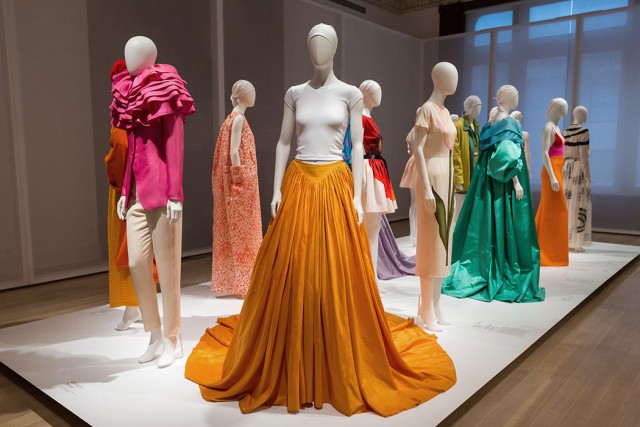
Jewish Museum exhibition highlights Isaac Mizrahi’s fashion design sense and colorful personality (photo by Will Ragozzino/SocialShutterbug.com)
The Jewish Museum
1109 Fifth Ave. at 92nd St.
Daily through August 7, $15 (free admission Saturday, pay-what-you-wish Thursday 5:00 – 8:00)
212-423-3200
www.thejewishmuseum.org
www.isaacmizrahi.com
“I feel like a filmmaker/playwright trapped in the body of a fashion designer . . . seriously,” Isaac Mizrahi says on the audioguide accompanying the sensational exhibition “Isaac Mizrahi: An Unruly History,” continuing at the Jewish Museum through August 7. Exhibition organizers Chee Pearlman and Kelly Taxter have done a fabulous job of creating a compelling narrative arc to the show, brilliantly bathing visitors in Mizrahi’s intense love of color (“Color is the biggest luxury there is.”), wild sense of humor (“I think that the ability to laugh at myself sets me apart. I don’t understand people without humor, and I just don’t like certain things because they have no humor.”), and proud dedication to both high and low culture, from movies and television to opera, theater, and art, from Woody Allen, Fred Astaire, and Bette Davis to The Red Shoes, Lucille Ball, and Egyptian hieroglyphics. The show also explores the Brooklyn-born-and-raised Mizrahi’s creative expression in a number of different media. Splendid fashion drawings, which are works of art on their own, cover two walls; the designer works out ideas for potential outfits in these small sketches of tall, thin models, their bodies filling the paper from top to bottom. Another room is like a runway through his career as a costume designer for choreographers Mark Morris and Twyla Tharp and as designer and director for the Opera Theatre of St. Louis, for whom he created playful, fantastical costumes and a dazzling blue satin dress with one of the longest trains you’re ever likely to see, wrapping around a staircase and across the floor (for the Queen of the Night in The Magic Flute). Another section sits the audience down for a montage of his numerous television and movie appearances, including hosting several programs of his own, competing on Celebrity Jeopardy!, guest judging on Project Runway, starring in his own one-man show (Les MIZrahi), selling his clothes at Target and on QVC, and making cameos galore. “Isaac is a polymath of many talents and does not take himself too seriously in that he doesn’t see himself as a grand fashion figure. What he is . . . is what you see,” Pearlman says on the audioguide. “There is an instant, infectious warmth to him. He channels a light, happy, joyous spirit which he unleashes in his clothing.”
Dozens of mannequins are adorned with Mizrahi’s unique designs, which reveal his personality, style, and endless ingenuity, which was first brought to the general public’s attention in the innovative 1995 documentary Unzipped. “Baby Bjorn Ballgown” is a striking red dress with a place for an infant in the front (“The birth of a child should be integrated into a woman’s social life.”). “The Real Thing” is a pailette dress made from flattened Coke cans, a sly riff on consumerism. “Desert Storm” celebrates camouflage in a new way. “Extreme Kilt” reimagines the Scottish traditional garb in cashmere flannel (“There’s a million rules about kilts, and about plaids, and I thought it was hilarious and I liked knowing everything about it and then being able to absolutely destroy this knowledge.”) “Kitchen Sink Pink Dress” was influenced by neon-light artist Dan Flavin, “Exploded Tulip” was based on an Irving Penn photograph, and “Grand Pupa” takes its name from its cocoonlike shape and the name of the leader of Fred Flintsone’s lodge. The exhibition also includes a series of photographs Nick Waplington took of Mizrahi at work from 1989 to 1993, clips from dance and theater performances that Mizrahi designed, directed, and/or appeared in, and a room of such accessories as “Lobster Epaulet,” “Cardboard Boater,” “Fox Piece,” “Spring Heeled Heels,” and “Campaign Box Clutch.” At the center of it all, Mizrahi’s love of life and fashion shine through, highlighting a fascinating rebel who has always insisted on doing things his own way. “I’m just going to be myself,” he says. To give as many people as possible a chance to see this superb midcareer retrospective, the Jewish Museum will be open on Wednesday (when it’s usually closed) and has extended viewing hours to 8:00 on Saturday (when it’s free) and Sunday.